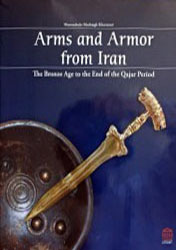Arms and Armor from Iran: The Bronze Age to the End of the Qajar Period
 The book «Arms and Armor from Iran: The Bronze Age to the End of the Qajar Period» consists of 780 pages, where you can find the research and descriptions of items from 10 museums and private collections. Half of the book is devoted to the history of Iranian weapons, while the second half presents beautiful illustrations of the studied items.
The book «Arms and Armor from Iran: The Bronze Age to the End of the Qajar Period» consists of 780 pages, where you can find the research and descriptions of items from 10 museums and private collections. Half of the book is devoted to the history of Iranian weapons, while the second half presents beautiful illustrations of the studied items.
CONTENTS
- 1. Introduction
- 2. The Iranian cultural influence in the region and the Iranian search for independence
- 3. Bronze and iron weapons from Iran
- 3.1 Casting bronze weapons
- 3.2 Bronze weapons from western parts of Iran (Luristan and Elam)
- 3.3 Classification of bronze and iron weapons from Luristan and other regions of Iran
- 3.4 Iron swords from Luristan
- 3.5 Bronze weapons from Hasanlu
- 3.6 Classification of daggers and swords from Marlik, Amlash, and Talesh
- 4. Median and Achaemenian daggers and swords
- 4.1 The Median akenakes (short sword)
- 4.2 The Persian akenakes
- 4.3 Achaemenian long sword
- 4.4 Achaemenian falchions
- 4.5 Achaemenian knives
- 5. Parthian swords and daggers
- 5.1 Evidence from rock reliefs
- 5.2 Archeological examples
- 6. Sassanian swords
- 6.1 Evidence from rock reliefs
- 6.2 Evidence from Silver plates
- 6.3 Archeological examples
- 7. The importance and meaning of the sword in Iran after the Muslim conquest
- 7.1 Crucible steel (Pulad-e gohardar or fulad-e johardar) and its varieties
- 7.2 Different types of steel
- 7.3 Pattern-welded steel blades (layered blades)
- 7.4 Classification of swords by al Kindi
- 7.5 Akhi Hizam Muhammad ibn Yaghub al Khuttali on swords
- 7.6 Beiruni on swords
- 7.7 Ibn Sina on swords
- 7.8 Khayyam Neishaburi on swords
- 7.9 Mobarakshah Fakhr Modabar on swords
- 7.10 Al Tarussi on swords
- 7.11 Identification and classification of watered-steel blades (tigheye johardar) based on publications from modern times
- 8. Shamshir (sword) and its varieties
- 8.1 Shamshir attributed to Timur with gold-inlaid cartouches in Kufic inscriptions from the National Museum of Iran, Tehran
- 8.2 Shamshir attributed to Timur with gold-inlaid cartouches in Kufic inscriptions from the Military Museum, Tehran
- 8.3 Another shamshir attributed to Timur from the Military Museum, Tehran
- 8.4 Different parts of a classical shamshir
- 9. The mystery behind dhufaghar “zolfaghar”, the bifurcated sword of Ali
- 10. Iranian straight swords: the re-emergence or coexistence with curved swords
- 11. Iranian military swords from the Qajar period (shamshir nezami)
- 12. Qame and qaddare (double-edged short sword and one-edged short sword)
- 13. Khanjar (double-edged dagger)
- 14. Kard (one-edged knife)
- 15. Pishqabz (double-curved, one-edged dagger)
- 16. Neyze and zubin (spear and javelin)
- 16.1 Spearheads from Marlik
- 16.2 Spearheads from Amlash
- 16.3 Spearheads from Amarlu
- 16.4 Spearheads from Luristan
- 16.5 Achaemenian spearheads
- 16.6 Parthian and Sassanian spearheads
- 16.7 Spears after the Muslim conquest
- 17. Gorz (mace)
- 17.1 Globular or pear-shaped and truncheon-shaped mace heads
- 17.2 Knobbed and flanged maces
- 17.3 Animal or human-headed maces
- 18. Tabar / Tabarzin (axe and saddleaxe)
- 19. Separ (shield)
- 20. Zereh and joshan (armor)
- 20.1 Joshan and zereh (mail)
- 20.2 Chahr ayne (four mirrors)
- 20.3 Sardushi (Shoulder padding)
- 20.4 Bazuband (arm guard)
- 20.5 Kolah khud (helmet)
- 20.6 Gariban (standard)
- 20.7 Zanuband (knee protector) and sagband (shin protector)
- 21. Tir va Kaman (bow and arrows)
- 21.1 Shapes and structure of a Kaman (bow)
- 21.2 Materials used for making a bow
- 21.3 Tir (arrow) and paykan (arrowhead)
- 22. The meaning of the emblem of the lion, the sun, and the lion fighting a bull on pieces of arms and armor
- 23. The Iranian warrior tradition: Iranian treatises on warfare and martial arts
- 23.1 Jawanmardi: rules of conduct and behavior for warriors
- 23.2 Ayyaran during the Sassanian period and in later eras
- 24. Koshti (wrestling), other martial practices, and their role in preparing the warriors for the battlefield
- 24.1 Wrestling and varzesh bastani
- 24.2 Practice tools of varzesh bastani
- 24.3 Archery training
- 24.4 Handling the sword
- 24.5 Throwing the javelin
- 24.6 Horse riding, polo, and playing at the mall
- 24.7 Stickfighting
- 25. Dervishes
- 26. Naggali (traditional reciting of Shahname)
- 27. Arms and armor used in taziye (Shiite passion play)
- 28. Conclusion
- 29. Catalog
The book is of a worldwide importance and is the main source to study Iranian weapons.
You can get the book here






